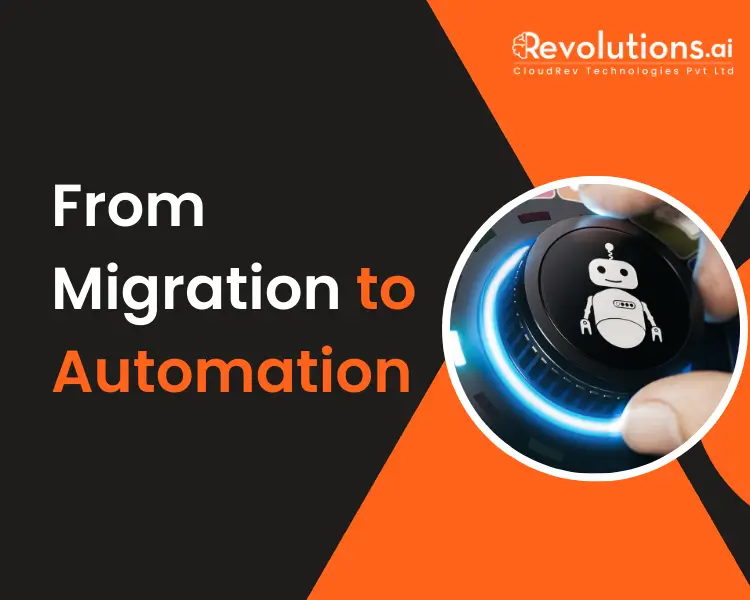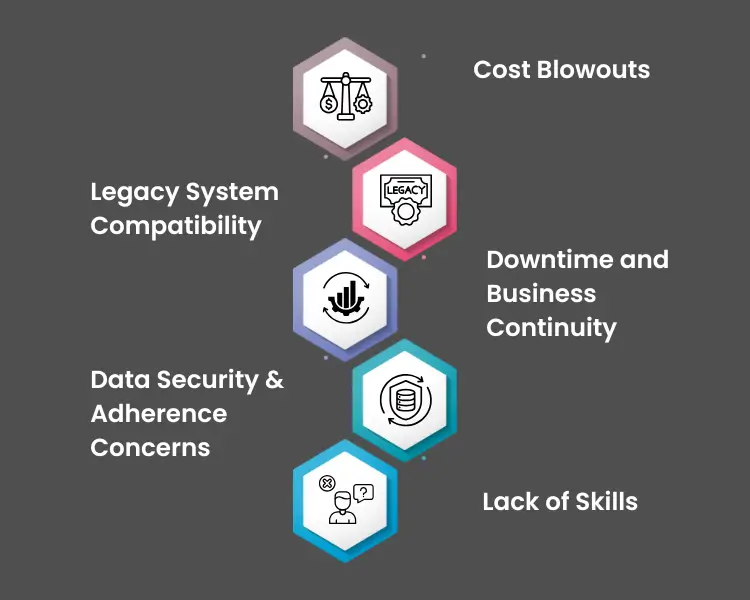Startups are looking to scale quickly without heavy upfront investment. Enterprises, on the other hand, are focused on modernizing legacy systems and using new efficiencies. Despite different goals, both share one thing in common: the need for a powerful, flexible cloud foundation. That’s exactly what AWS cloud solutions deliver: scalable infrastructure, global reach, and the reliability required to drive real digital transformation, no matter the business size or stage.
But let’s be real, migration is just the beginning. What happens after you’ve moved your workloads to the cloud? That’s when the real transformation kicks in. From simplifying operations to automating everyday tasks, businesses can see new levels of quicand innovation by going beyond just “lift and shift.”
Here in this blog, we will understand how AWS is assisting organisations to shift from mere migration to automation. From cost optimisation, upgraded agility to creating AI-driven workflows, AWS is not a platform nor a cloud provider; it’s a digital transformation enabler in the long term. Let’s see why AWS is not just a cloud provider.
How Does AWS Simplify Cloud Migration for Enterprises?
For most companies, a move to the cloud is a big step and also, for the most part, a complex one. AWS simplifies the process by offering an official pathway with its Migration Acceleration Program (MAP). The program helps to vet readiness, set goals, and create a simple plan tailored to each company’s specific needs.
Organisations take advantage of a wide variety of AWS-native capabilities like AWS Application Migration Service, Database Migration Service, and Snowball to maintain large-scale migrations with little disruption. Also, teams can also move mission-critical workloads, applications, and databases without rewrites, saving time and expense.
Once migration is complete, the next logical priorities are optimisation and automation. That’s where AWS cloud automation steps in, helping organisations to optimise resources, scale operations on demand, and minimise manual effort across their IT environments.
What are the Most Typical Challenges During AWS Cloud Migration?
Firms typically face significant hindrances to migration, mainly when migrating from traditional infrastructure to the cloud. Let us discuss common hindrances and how AWS cloud solutions make them easy.
- Legacy System Compatibility
The majority of companies don’t function on overnight cloud-capable legacy systems. These take time to pass through replatforming or re-architecting, and more complexity. AWS also possesses hybrid capabilities and modernisation tools that enable system continuity and smooth transition. - Lack of Skills
Lack of experienced cloud professionals could hinder migration. However, AWS has end-to-end documentation, training manuals, and partner network support to overcome the skills gap and reduce learning curves. - Data Security & Adherence Concerns
Businesses are worried about how their sensitive information will be protected during transit and post-migration. Additionally, AWS uses strong in-place security models and Adherences across a broad vertical industry base, which gives peace of mind. - Cost Blowouts
Migration costs can spiral out of control if not planned quickly. AWS also provides controls like the AWS Pricing Calculator and Cost Explorer to allow companies to accurately estimate, track, and manage costs. - Downtime and Business Continuity
Zero downtime is necessary for the majority of businesses. AWS also supports phased or staged migrations with failover configurations and real-time sync tools, reducing service interruption and continuity.
How are Legacy Systems Modernised Using AWS Services?
Legacy infrastructure is typically the foundation of business activity, without encouraging innovation. However, AWS is a pragmatic and visionary path to modernisation. Rather than needing a complete rip-out, it allows organisations to migrate workloads in incremental phases without sacrificing operational integrity.
AWS makes it easier to modernise legacy systems by first helping businesses understand what they already have. Tools like Migration Hub and Application Discovery Service analyse the existing infrastructure and highlight which applications are ready to move. Once that’s clear, services like AWS Elastic Beanstalk, ECS, and Lambda come into play, offering modern deployment options like containers and serverless computing.
By breaking down monolithic architectures into microservices, with their modularity, organisations can upgrade development cycles, accelerate agility, and rid themselves of technical debt. With this transition, driven by AWS technologies, organisations can transform legacy systems into next-generation digital platforms without sacrificing functionality or reliability.
How is Adherence Achieved Using AWS in Regulated Environments?
Meeting Adherence requirements is a top priority for businesses in regulated industries such as healthcare, finance, and government. These sectors must adhere to strict legal and operational standards like HIPAA, PCI-DSS, GDPR, and FedRAMP. AWS helps organisations maintain Adherence by offering a robust set of tools, pre-built frameworks, and third-party certifications that align with global regulations.
AWS offers services like AWS Config, CloudTrail, and Identity and Access Management (IAM) to support continuous monitoring, secure access, and policy enforcement. These tools enable real-time visibility into infrastructure changes and ensure that configurations remain compliant over time. Encryption, both at rest and in transit, is another core feature that helps protect sensitive data while meeting industry-specific standards.
What makes the process even more seamless is the integration of Adherence-focused features into AWS migration services, allowing enterprises to embed security and regulatory controls during the transition itself, not after. This proactive approach reduces risk, shortens the audit timeline, and ensures that businesses can scale confidently in the cloud.
Which Trends are Shaping the Future of AWS Cloud Solutions Adoption?
The next wave of cloud adoption is becoming increasingly data-driven and dynamic. As cloud usage expands across industries, new trends are emerging around how AWS is being adopted and the rising demand for its capabilities.
- AI-Driven Cloud Automation- With AI and ML increasingly being deeply integrated into day-to-day workflows, AWS is providing increasingly intelligent automation from anomaly detection to auto-scaling, making the infrastructure autonomous and predictive.
- Edge and Hybrid Cloud Models- Organisations are influencing AWS Outposts and Wavelength to bring cloud capabilities closer to where data is being created to upgrade latency and Adherence in remote or hybrid environments.
- Sustainable Cloud Practices- With green technology stepping into the limelight, AWS is accelerating sustainability through carbon footprint monitoring solutions and less power-consuming infrastructure to enable ESG ambitions.
- Low-Code/No-Code Development- Developer and business teams are adopting the likes of AWS Honeycode to build apps at pace with reduced coding, thus reducing development cycles.
- Cyber Resilience and Zero Trust Architecture- Cyber threats change, and so does AWS. With features like microsegmentation, IAM roles, and encryption over transport, the platform is doubling down on security-first practices.
- Expanding Ecosystem – With AWS managed services, organisations can tap into the large catalogue of partner tools, integrations, and APIs to build more flexible and powerful cloud customisations than ever before.
Conclusion
Digital transformation is not a buzzword, but a fact. Whether it begins with data migration or whether addressed head-on with app modernisation, AWS cloud solutions offer the tools, automation, and consistency that modern businesses need. From Adherence to on-demand scalability, AWS makes cloud adoption an IT project transformed into a business strategy.
While digital demands evolve, companies require a technology partner who grasps both the innovation and the infrastructure. Revolution AI offers customised AWS services, from strategy through execution, helping businesses use the full value of the cloud. Looking to move beyond migration and into automation? Now is the perfect time to turn that transformation into lasting impact.
Frequently Asked Questions
AWS automation refers to using AWS tools and services to streamline and manage cloud operations with minimal manual intervention. It helps improve efficiency, reduce human error, and speed up development cycles—crucial for digital transformation.
The duration of an AWS cloud migration depends on the complexity and size of the workloads. Small-scale migrations can take a few weeks, while enterprise-level transitions may span several months, especially when legacy systems are involved.
Yes. AWS offers tools to rehost or replatform legacy systems without complete redesign. Services like AWS Application Migration Service and hybrid cloud support enable gradual modernization while maintaining critical functionality.
AWS provides end-to-end encryption, access controls, Adherence frameworks, and monitoring tools to protect data during migration. Services like AWS IAM, CloudTrail, and KMS help maintain strong security throughout the process.
Industries such as finance, healthcare, retail, manufacturing, and government gain significantly from AWS adoption due to the platform’s scalability, automation, Adherence features, and broad service ecosystem.

Hemal Sehgal
Introducing Hemal Sehgal, a talented and accomplished author with a passion for content writing and a specialization in the blockchain industry. With over two years of experience, Hemal Sehgal has established a strong foothold in the writing world, c...read more




